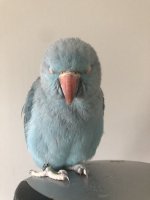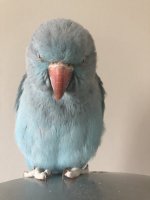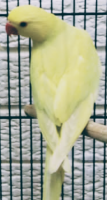Christian V
Moving in
- Joined
- 6/21/18
- Messages
- 7
Hello!
I’ve had a Blue African Ringneck for two years now. She is not tame because sadly she was abused by her previous owner so she doesn’t trust people, especially hands. Ever since we got her she has been making a very strange noise/stance, what she does is, she lifts her head slitghty, puffs up, then makes a strange noise and decrease her pupils size. She does this a lot when she is close to me or any other family member, she likes in my room and has basically trashed it, I can give her food by hand but she doesn’t want to eat from my hand but she can happily take it and fly away with it and then eat.
What I really need answered is:
Does anyone know about that strange noise she does & does anyone know how I can get her to really trust me. I’ve almost tried everything and nothing works, I’ve done some progress with clicker training but she still doesn’t trust me.
I’ve had a Blue African Ringneck for two years now. She is not tame because sadly she was abused by her previous owner so she doesn’t trust people, especially hands. Ever since we got her she has been making a very strange noise/stance, what she does is, she lifts her head slitghty, puffs up, then makes a strange noise and decrease her pupils size. She does this a lot when she is close to me or any other family member, she likes in my room and has basically trashed it, I can give her food by hand but she doesn’t want to eat from my hand but she can happily take it and fly away with it and then eat.
What I really need answered is:
Does anyone know about that strange noise she does & does anyone know how I can get her to really trust me. I’ve almost tried everything and nothing works, I’ve done some progress with clicker training but she still doesn’t trust me.



 , I wonder how I can get my own pixel art of my IRN Blue Female and my Orange Caique.
, I wonder how I can get my own pixel art of my IRN Blue Female and my Orange Caique.


 The puffiness I don't know.
The puffiness I don't know.

 Let patience be your friend. I hope this helps some.
Let patience be your friend. I hope this helps some.
